#polyclitus
Text
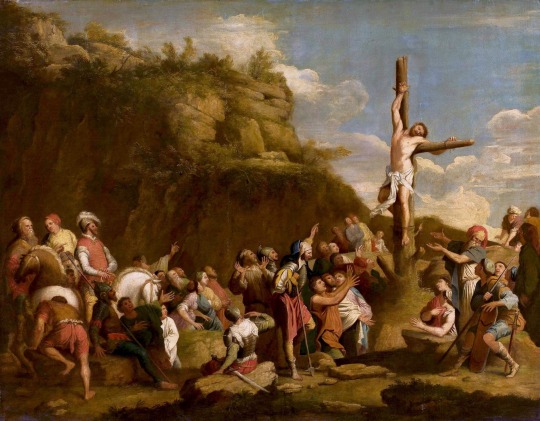
Crucifixion of Polyclitus (1650s, oil on canvas) | Salvator Rosa
#art#fine art#painting#oil painting#17th century#crucifixion of polyclitus#salvator rosa#religious art#crucifixion
16 notes
·
View notes
Text

the pencil of nature, karen knorr, 1994 (from the artist's website)
Karen Knorr is a German-born, British-based photographer whose work challenges conventional histories of representation. This photograph is part of her series Academies (1994-2001), images taken in fine-art academies and museums across northern Europe that reflect on the production, transmission, and consumption of art in the West.
In choosing to title this piece The Pencil of Nature, Knorr draws a direct line between William Henry Fox Talbot's foundational book of photography [...] and Pliny's tale of the Corinthian Maid [who invented painting when she traced the shadow of her departing lover on the wall]. Staged in a traditional fine-arts institution featuring plaster casts of Classical male nudes (here, a Roman copy of Polyclitus's Doryphoros), the scene re-creates a seminal narrative of art-making, linking the invention of painting (graphikê in Greek) to her medium of photography: both are forms of "drawing with light."
text from the Johnson Museum of Art's "Wonder and Wakefulness: The Nature of Pliny the Elder"
6 notes
·
View notes
Text
Ababa Abaris Abel Abelus Abrahamus Abundantius Acanthio Achillas Acropolistis Adam Adamus Adelardus Adelphasium Ademarus Adephonsus Adhelina Adimantus Adolphus Adriana Adrianus Aegidius Aethalides Aethalos Agathon Agnes Agorastocles Alanus Alaricus Albanus Albertus Albinus Albiorix Alcesimarchus Alcesimus Alco Alexis Alexius Alfredus Alienor Alienora Amadea Amadeus Amalec Amaryllis Ampelisca Andreas Andria Angela Angelus Anna Anselmus Antamoenides Anterastilis Antiochus Antipho Antoninus Apollonius Appendix Aquila Archimedes Argyrippus Ariadna Ariadne Arion Aristobulus Aristophanes Aristophontes Aristoteles Arius Artamo Artemona Arthurus Asa Aspasius Astaphium Augustina Aurelianus Aurelio Aurelius Aureolus Autlesbis Auxilium B Bacchis Baebio Balduinus Ballio Barlaam Bathuel Beata Beatrix Belisarius Benedictus Beniaminus Berengarius Bernardus Bissula Blaedarus Blepharo Branimerus Branimirus Brannimerus Brenamir Bromia Bruno Budimerus Budimiro C Cacistus Cainus Calidorus Callicles Callidamates Callipho Candidus Cappadox Cario Carolus Casimirus Casina Chalinus Cham Chamus Charinus Charmides Christophorus Chrysalus Chrysides Chrysippus Citrio Citro Clarissa Cleareta
Cleomachus Cleopater Cleostrata Collybiscus Cresimirus Crocotium Cunimundus Curculio Curmisagius Cyamus Cylindrus Cynthia Cynthius D Daedalus Daemones Debora Decebalus Delphium Demaenetus Demaratus Demetrius Demipho Demiphones Didacus Dinia Diniarchus Diodorus Dionysia Dionysius Dirsisclaus Diudituslaus Dobrosclavus Domagous Dommagous Domogous Dordalus Dorippa Draccius E Ecbertus Edom Edwardus Egeria Egerius Eleusium Elianor Elianora Eliezer Eligius English Epidicus Epignomus Erasmus Ergasilus Ericus Erotium Esaus Ethelredus Etleva Euclio Eugenius Euhodia Eunomia Eupator Eurydice Eutychus F Feliciana Felicianus Felicitas Ferdinandus Fides Firminus forms Francisca Franciscus Friderica Fridericus G Gaisericus Galileus Gallicles Gamaliel Gaudentius Geisericus Gelasimus Gelasius Gelimer Gensericus Gentius Georgius Gerbertus Gerlachus Gervasius Giddenis Gildasius Gisgo given Godefridus Gorgines Goyslauus Griffinus Gripus Grumio Gualterius Gulielmus Gundulfus Gustavus Gymnasium H Hadrianus Halisca Hamilcar Hanno Harpax Hasdrubal Hegio Helionordis Hellas Henricus Hermes Hesychius Hieronymus Hippocrates Hippolytus Hircanus Hugo Humbertus Hyroeades I Iacobus Iamblichus Ianuarius Iaphet Iaphetus Ignatius Ioannes Iordanes Iosepha Iosephus Iosue Isidora Isidorus Iulia Iustinianus Iustinus J Jeremias Juntinus K Karolus L Labanus Labrax Ladasclavus Lampadio Latin Laurentius Leaena Lemniselenis Lena Leonardus Leonida Lesbonicus Levi Lia Linus Lisia Ludovicus Lyco Lyconides Lycus Lydia Lydus Lysidamus Lysimachus Lystiteles M Maglocunus Manasses Marcion Maria Martina Martinus Mattathias Matthaeus Megadorus Megaronides Melaenis Mellita Menaechmus Messenio Meto Michael Milphidippa Milphio Misargyrides Mnesilochus Moderatus Modesta Modestus Muntimerus Myrrhina Mys N Naim names Neapolio Nechos Nicander Nicanor Nicobulus Nicodemus Nicolaus Noemus O of Olaus Olympio Orontes Orontianus Orontius P Paegnium Palaestra Palinurus Panaetius Panegyris Paphnutius Pardalisca Paris Pasicompsa Patricius Paula Pellio Peniculus Periphanes Perseus Petra Petronella Petrus Phaedria Phaedromus Phanostrata Philadelphus Philaenium Philematium Philippa Philippus Philocrates Philoctetes Philolaches Philomela Philomelus Philopolemus Philoxenus Philto Photinus Phronesium Phygia Pistoclerus Pius Planesium Plesidippus Pleusicles Plutarchus Polybius Polybus Polycarpus Polycletus Polyclitus Polyphemos
Polyphemus Pompilla Pompillus Pomptilla Pompylus Posidonius Pribislavus Procopius Pseudolus Ptolemaeus Ptolemocratia Putiphar Q Quartilla Quintinus R Rachel Radosclavus Radoslavus Raphael Rebecca Renartus Renatus Rhescuporis Roberta Robertus Rodericus Rogerius Roletus Romanus Ruben S Sagaristio Saladinus Salvillus Salvinus Sangarinus Sara Saturio Scapha Sceledrus Sceparnio Scorylo Selenium Sem Semus Sergius Severinus Simo Simon Socration Sophocles Sophoclidisca Sosicles Soteris Sparax Spartacus Sphaerio Stadius Stalagmus Staphyla Stasimus Stephana Stephanium Stephanus Stratippocles Stratophanes Strobilus Sulpicio Syncerastus Syra T Tanais Tanaquil Tancorix Tedusia Tedusius Telestis Terpimerus Testilus Themistius Theodericus Theodora Theodorus Theodosia Theodosius Theopropides Therapontigonus Thestilus Thestylis Thestylus Thomas Tiberius Tlepolemus Tobias Toxilus Trachalio Tranio Triphon Truculentus Turbalio Tycho Tyndarus U Urbanus Ursula V Veronica Vesclevesis Vidus Vincentius Virgo Vitalis Vladimirus Vortigernus Vuissasclavus W Wilielmus Wissisclaus Woiiomyr Y Ysengrimus Z Zeno Zenobius Zenodorus Zenon Zenonina Zenothemis Zoilus
0 notes
Text
“All this is typical Hellenistic mythography; but the question is whether there is any evidence to show that the legends which had grown up in the neighbourhood of the two mountains had any basis in primitive beliefs. Now although we are ignorant of the age of the sanctuaries which Pausanias saw on the mountains, he does say that the statue of Hera was the work of Polyclitus; which would mean that the cuckoo-tipped sceptre dated back to about 423 B. C. The birds on the sima of the Argive Heraeum are probably cuckoos,74 but Hera, like Athena, was associated with birds of various species. She is accompanied by a falcon on an Attic red-figured lekythos, now in Providence, R. I.,75 which is probably by the Brygos painter, while a bronze dove was found in her temenos at Perachora.76 In Roman times Juno was associated with the peacock. The cuckoo, as the harbinger of spring, has always been associated with husbandry, and Euelpides' comment would appear to glance at this fact. But it is also true that Aristophanes is at pains to associate the bird especially with Egypt and Phoenicia, and not with his homeland, so that whatever the reason for the cuckoo sceptre at the Heraeum there seems no reason to suppose that the poet had the Argive cult in mind when he wrote this passage. A. B. Cook thought otherwise, considering that the second half of the name Nephelokokkygia, and the introduction of Basileia, whom he identifies with Hera, represented a deliberate attempt on the part of the poet to curry favour with the state which at that time held the balance of power between Athens and Sparta. Jane Harrison too considered that Nephelokokkygia was intended to remind the audience of the Argive mount Kokkygion, and the legends associated with it. " Turning finally to literature, it is, I am convinced, on no mere fancy of the comedian but on the actual foundation of ancient bird-cultus, that Cloud-cuckoo-town, Nephelokokkygia, is built. Did not Zeus himself woo Hera in the form of a cuckoo ? The Sky-Father in bird form woos the Earth-Maiden. He wooed her on the mountain Kokkygion near Sparta, and, for that, Pausanias says, was a cuckoo perched on Hera's sceptre." But the weakness of this argument is that there is nothing to show that the story of Zeus and the cuckoo is not an aetiological myth invented perhaps to explain certain features associated with the Argive cult of Hera. On the other hand the association of Hera with the cuckoo may be a legacy from Mycenaean times. All that can be safely concluded from the ancient evidence with reference to cuckoo cults is that:
A. Legends were apparently extant in Aristophanes' time to the effect that the " cuckoo " had once ruled in Egypt and Phoenicia. The precise nature of these legends we do not know.
B. The cuckoo was associated in ancient times with the coming of Spring, and with husbandry.
C. Sanctuaries, of unknown antiquity, dedicated to Zeus and Hera existed on Mounts Kokkygion and Pron in Pausanias' time. Mount Kokkygion was formerly known as Mount Thornax, and was associated with a myth, probably of a late and aetiological nature, which told how Zeus first visited Hera in the form of a cuckoo.
D. The association of Hera and the cuckoo may possess Minoan-Mycenaean affinities, but there is no evidence to show that Zeus was ever associated with the bird.
E. There is no evidence to show that Aristophanes had the Argive cult of Hera in mind when he wrote the passage which we have been considering.”
- J. R. T. Pollard, The Birds of Aristophanes - A Sourcebook for Old Beliefs
1 note
·
View note
Photo

The so-called Diadoumenos (youth binding his brow with a fillet). Roman marble copy of the Flavian period (69-96 CE) after a lost bronze original by the Argive sculptor Polyclitus (fl. ca. 450-415 BCE). Now in the Metropolitan Museum of Art.
#classics#tagamemnon#Ancient Greece#Classical Greece#Ancient Rome#Roman Empire#art#art history#ancient art#Greek art#Ancient Greek art#Classical Greek art#Roman art#Ancient Roman art#Roman Imperial art#Polyclitus#Polykleitos#Diadoumenos#sculpture#statue#marble#stonework#carving#Metropolitan Museum of Art
158 notes
·
View notes
Photo
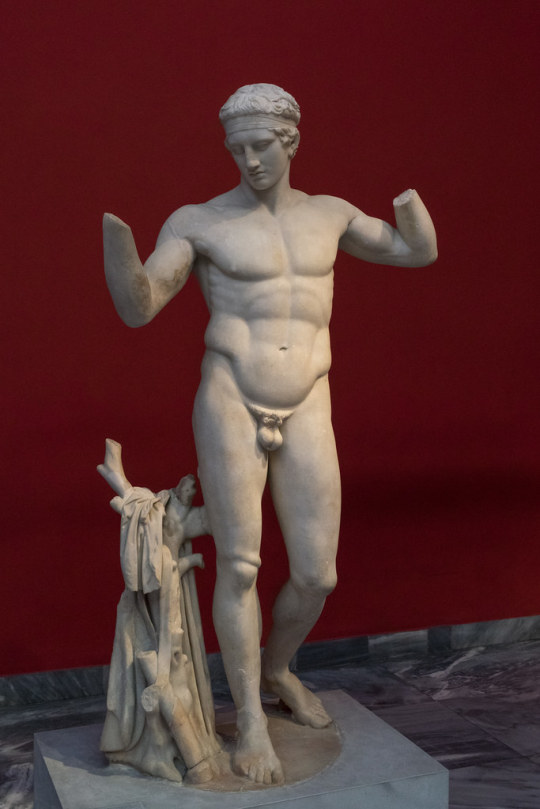

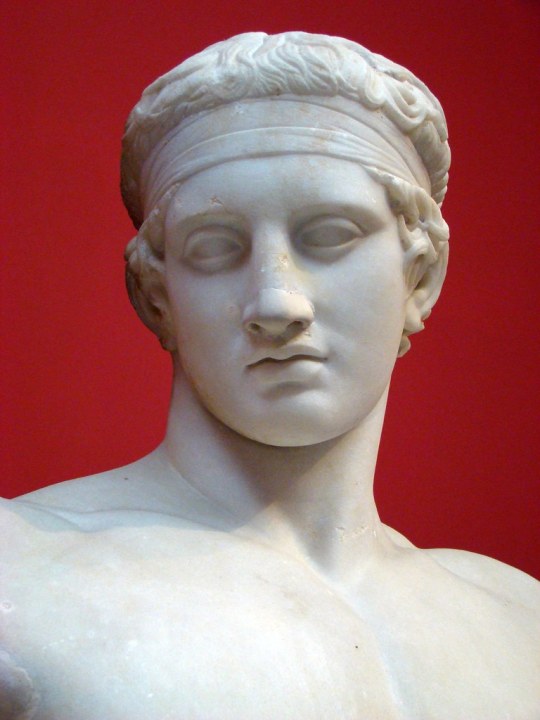
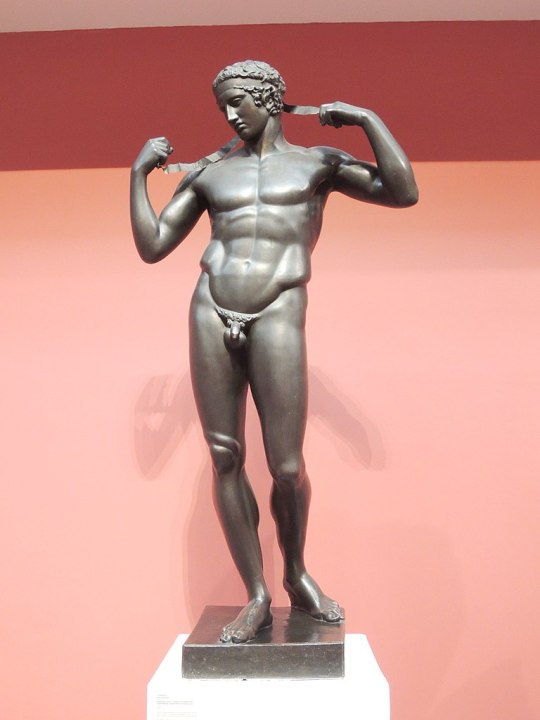
The Diadumenos ("diadem-bearer")
Delos, Greece
100 BCE
1.95 meters high
The Diadumenos is the winner of an athletic contest at a games, still nude after the contest and lifting his arms to knot the diadem, a ribbon-band that identifies the winner and which in the bronze original of about 420 BCE would have been represented by a ribbon of bronze. The figure stands in contrapposto with his weight on his right foot, his left knee slightly bent and his head inclined slightly to the right, self-contained, seeming to be lost in thought. Phidias was credited with a statue of a victor at Olympia in the act of tying the fillet around his head; besides Polyclitus, his successors Lysippos and Scopas also created figures of this kind.
#art#history#travel#delos#greece#greek statue#greek sculpture#statue#sculpture#1 bce#polykleitos#polycleitus
293 notes
·
View notes
Photo
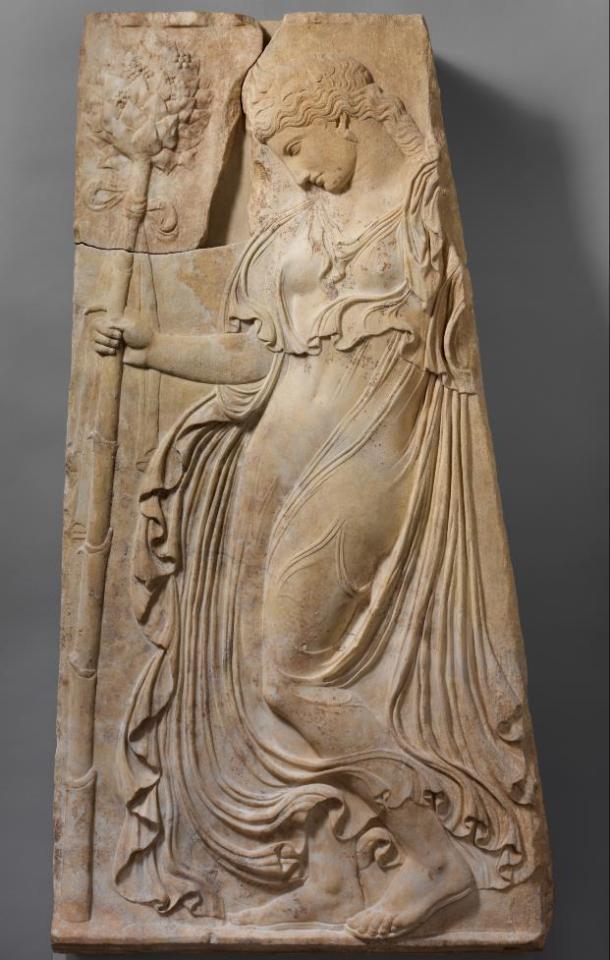
MWW Artwork of the Day (8/25/21)
Kallimachos (Greek, fl. late 5th c. BCE)
Dancing Maenad (c. 425-400 BCE)
Roman copy (1st c. CE) of a Greek relief, 143 cm. high
The Metropolitan Museum of Art, New York (Fletcher Fund)
As female votaries of Dionysos, maenads abandoned themselves to orgiastic festivities. They celebrated the rites of the god with song, dance, and music in the mountains, often clothed in animal skins. This dancing maenad, clothed in a diaphanous chiton, carries an object characteristic of Dionysos' retinue, the thyrsos, which consists of a fennel stalk crowned with a pinecone and ivy berries. The voluminous garment swirls about her in fanciful, highly expressive folds that evoke her dance. Her introspective expression, so typical of art of the Classical period, contrasts most effectively with the exuberance of her drapery. Callimachos was an architect and sculptor working in the second half of the 5th century BCE in the manner established by Polyclitus.
For more Ancient Greek sculpture, see this MWW Special Collection:
https://www.facebook.com/media/set/?vanity=TheMuseumWithoutWalls&set=a.419770264795015
2 notes
·
View notes
Text
As Polyclitus Said, Perfection Comes Bittle By Bittle
Author: @tomatowrites
Written for: @queerofcups
Rating: Mature
Word Count: 3138
Pairing: Eric “Bitty” Bittle/Kent “Parse” Parson/Jack Zimmermann
Summary: ROMAN MARBLE TORSO OF POLYCLITUS' "DRESDEN YOUTH" -- CIRCA FIRST QUARTER OF THE 1ST CENTURY A.D.
26 3/8 in. (67 cm.) high
Provenance - Elsa Bloch-Diener collection, Bern, acquired prior to 1988.
Really, when you get down into it, the size of the whole affair is a matter of perspective!
17 notes
·
View notes
Photo
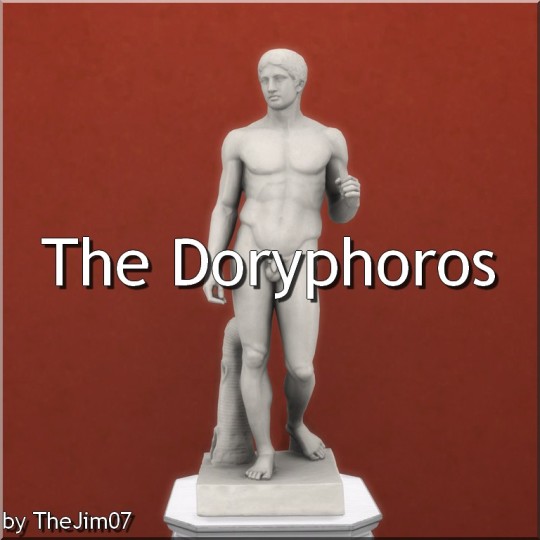

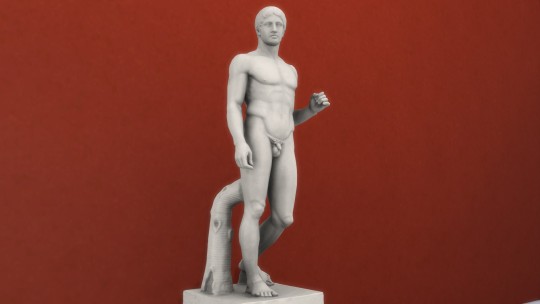


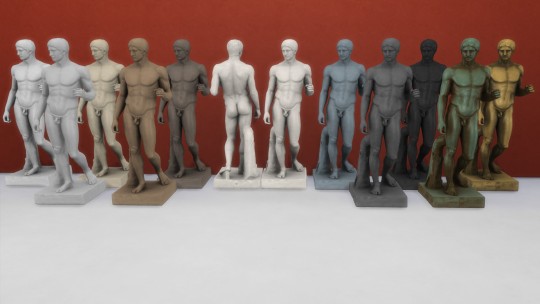
The Doryphoros
Hi everyone !
The Doryphoros (The Spear Bearer) represents the strict, classical ideal of maleness. Here we find a serene, harmonious, muscular soldier ready for battle. The original was created by Polyclitus, who wrote a treatise on the correct proportions of a canonical work, and his sculptures were copied in great numbers.
I made this statue from a free 3D model I found on the Internet. I reduced significantly the number of faces (275 000 to 9 600), built an UV map, normal map and textures.

Happy Simming !
Jim
Polygon Counts:
Object: High/Medium/Low
Statue: 9629/4815/2407
Additional Credits:
https://www.myminifactory.com/object/3d-print-doryphoros-the-spear-bearer-25158
Blender, TSRW, S4S.
DOWNLOAD (SimFileShare)
Alternative LINK
If you want to support me, you can buy me a coffee in my Ko-Fi page:
Support TheJim07
Thanks!
134 notes
·
View notes
Photo
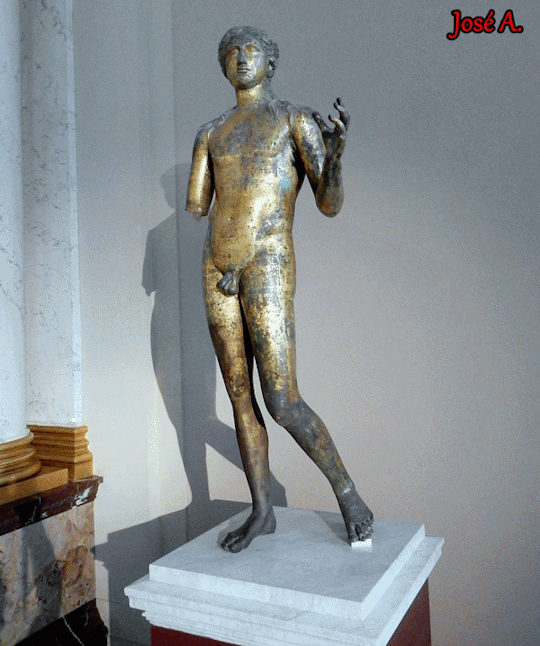
Apolo, siglo II d.C.
Procedencia: cerca del teatro galo-romano, Lillebonne (Seine-Maritime), Francia
Producción galo-romana
Bronce dorado. Las áreas superpuestas con hoja de oro aplicada con la ayuda de mercurio forman una cuadrícula que todavía es visible en lugares, particularmente en los muslos
H. 1,94 m
Adquirido en 1853
Descubierta en 1823, cerca del antiguo teatro de Lillebonne, esta es la estatua de bronce más grande de una deidad que ha sobrevivido de la antigua Galia. Apolo, considerado un dios benéfico, tenía una lejía en su mano izquierda - una configuración que era particularmente favorecida en el norte y centro-este de la Galia. Las proporciones y el equilibrio de la figura, y la forma en que se arregla el cabello, atestiguan la fuerte influencia de las formas griegas del siglo IV a. C. en los artistas galo-romanos.
Las tribulaciones y restauraciones del Lillebonne Apollo
Esta estatua de bronce dorado fue descubierta el 24 de julio de 1823, en las inmediaciones del antiguo teatro de Lillebonne (cerca de Rouen, en la región Sena-Maritime). Fue vendido en Inglaterra y permaneció en Londres durante casi treinta años en manos del coleccionista Samuel Woodburn, quien esperaba venderlo al Museo Británico. En 1853, fue comprado por el Estado francés y se unió a las colecciones del Louvre. La estatua, que representa al dios Apolo, fue fundida en varias secciones utilizando el método de cera perdida. Fue restaurado en muchas ocasiones, tal vez a partir del período clásico. La presencia de numerosas marcas de unión en la superficie del bronce explicaría la presencia del dorado, que se hizo con hoja de oro. Es difícil estar seguro de la fecha del dorado; la estatua pudo haber sido dorada en el momento en que fue fundida, luego por segunda vez al final del período imperial romano.
El culto de Apolo en la Galia
El Lillebonne Apollo es una de las estatuas de bronce más grandes que han sobrevivido de la antigua Galia. El dios de aspecto juvenil está completamente desnudo y originalmente habrá tenido una lejía (ahora perdida) en su mano izquierda, una configuración que fue particularmente muy valorada en el norte y centro-este de la Galia, donde se han encontrado estatuillas votivas similares en grandes cantidades. Apolo era considerado un dios benéfico, sanador y se asoció con varias otras deidades locales, a menudo mal definidas - Amarcolitanus, sin duda, así como Belenus, Borvo, Cobledulitavus, Grannus, Moritasgus, Vindonnus, y Virotutis. Muchos santuarios galo-romanos llevan marcas del culto de Apolo, estén o no situados cerca de manantiales con propiedades curativas.
Una obra galo-romana inspirada en un modelo griego
Las proporciones y el equilibrio de la estatua de Lillebonne, junto con la forma en que se arregla el cabello, demuestran la influencia de los modelos griegos en los artistas de la Galia romana. Realizada en el siglo II d.C. en la región de Lugdunum (actualLyons), la escultura se inspira gran parte de su inspiración en la tradición clásica. Imita el "contrapposto" desarrollado por Polyclitus a mediados del siglo V a. C. y se hace eco de las siluetas (igualmente cercanas a la adolescencia) de las figuras masculinas creadas en el siglo IV por escultores como Praxiteles, Euphranor y Scopas; también adopta el canon de formas extremadamente alargadas que se ven en las obras de Lysippus, en las que las proporciones de la cabeza se reducen deliberadamente. La postura y las características del dios también se toman prestadas del repertorio artístico de la antigua Grecia.
Bibliografía
B. Tailliez, "Trente ans d'histoire de l'Apollon de Lillebonne", Revue du Louvre et des musées de France, 1982, 2, p. 81-88, fig. 1, 3-6.
N. Duval, "L'Apollon de Lillebonne de l'abbé Cochet á nos jours, tribulations et restaurations", Centenaire de l'abbé Cochet, 1975, Actes du colloque international d'archéologie, Rouen, 1978, p. 265-286.
P. Zanker, Klassizistische Statuen, Maguncia, 1974, págs. 103-104, n 6.
E. Espérandieu, H. Rolland, Bronzes antiques de la Seine-Maritime, XIIIe supplément á Gallia, 1959, p. 24-25, n 10, pl. 3-5.
Información del Musée du Louvre.
13 notes
·
View notes
Text


Apollo of Mantua
The Apollo of Mantua and its variants are early forms of the Apollo Citharoedus statue type, in which the god holds the cithara in his left arm.
The type-piece is named for its location at Mantua; the type is represented by neo-Attic Imperial Roman copies of the late 1st or early 2nd century, modelled upon a supposed Greek bronze original made in the second quarter of the 5th century BCE, in a style similar to works of Polyclitus but more archaic.
(National Archaeological Museum, Mantua.)
130 notes
·
View notes
Photo
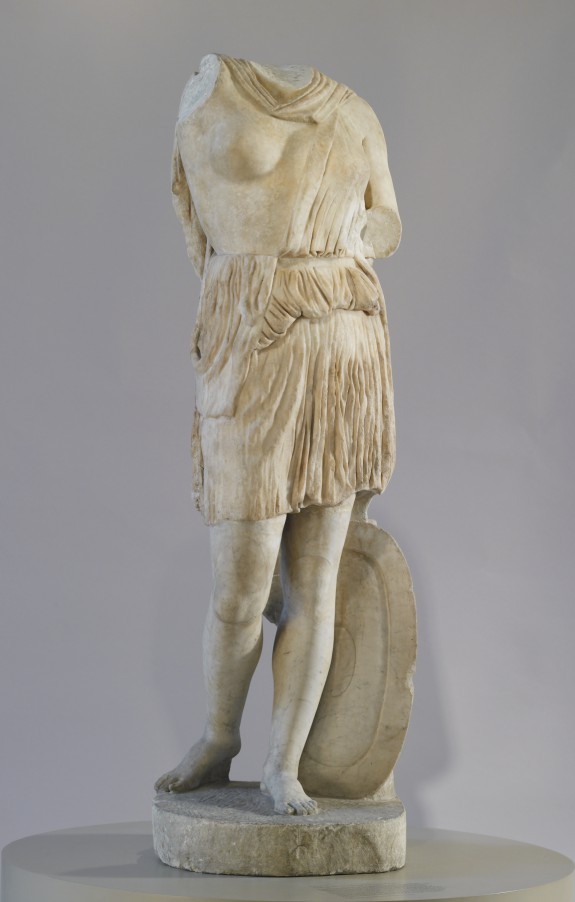
Art of the Day: Amazon

In mythology, Amazons were mighty female warriors who fought against the Greeks. These sensual but fierce women offered Classical sculptors the opportunity to depict the bared female breast. This statue reproduces a famous Greek original depicting an Amazon wounded beneath her right breast. It was one of several statues of Amazons entered in a sculptors' competition at the Temple of Artemis at Ephesus in western Asia Minor, about 440 BC. The sculptor of this entry is believed to have been Kresilas. According to the ancient writer Pliny, the contest was judged by the sculptors themselves, and each voted for his own first and gave second place honors to a work by Polyclitus, making him the winner. Kresilas received third prize. Learn more about this object in our art site: http://bit.ly/2Z7bfKI
32 notes
·
View notes
Photo

..
#ancient#sculpture#archaeological museum#greek mythology#tübingen#tuebingen#antik#original photography#skulptur#classical art#griechische mythology#archaeology#archäologie#plaster cast#gipsabguss#head#statue#Polyclitus#polyklet#5th century BC#5. Jh. v. Chr.#greek sculpture#polykleitos#amazon#amazone#classical greece#griechische klassik#archaeological#archäologisch#mythology
6 notes
·
View notes